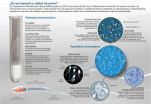(Press-News.org) The mere mention of the word "herpes" usually conjures negative images and stereotypes, but most people have been infected with some form of the virus. For most, a sore appears, heals and is forgotten, although the virus remains latent just waiting for the right circumstances to come back. Now, the mystery behind what triggers the virus to become active again is closer to being solved thanks to new research published in the Journal of Leukocyte Biology's November 2012 issue. In the report, scientists show how the immune system may lose its control over the virus when facing new microbial threats, such as when it must fend off other viral invaders or bacteria.
"Because almost all people are infected by one or more herpes family viruses during their lifetime, the potential impact of these findings are significant," said Charles H. Cook, M.D., FACS, FCCM, director of surgical critical care at The Ohio State University College of Medicine in Columbus, Ohio, and a researcher involved in the work. "We hope that by understanding how these latent viral infections are controlled that we can prevent reactivation events and improve people's lives."
To make this discovery, researchers studied mice with latent herpes family cytomegalovirus (CMV) during severe bacterial infections. They found that T-cells responsible for CMV control were reduced significantly during a new infection with bacteria. This, in effect, reduced the "brakes" which kept the virus under control, allowing the virus to reactivate and cause disease. When the immune system eventually sensed the reactivation, the memory T-cell levels returned to normal, effectively restoring the body's control over the virus.
"Finding ways to control herpes flare ups is important, not only for the health of the person with the virus, but also for preventing its transmission," said John Wherry, Ph.D., Deputy Editor of the Journal of Leukocyte Biology. "This report highlights the important interplay when we are 'co-infected' with more than one microbe and provides important insights into why the immune system sometimes fails as well as how it can regain control of latent herpes virus infections."
###
The Journal of Leukocyte Biology publishes peer-reviewed manuscripts on original investigations focusing on the cellular and molecular biology of leukocytes and on the origins, the developmental biology, biochemistry and functions of granulocytes, lymphocytes, mononuclear phagocytes and other cells involved in host defense and inflammation. The Journal of Leukocyte Biology is published by the Society for Leukocyte Biology.
Details: Jonathan Campbell, Joanne Trgovcich, Michelle Kincaid, Peter D. Zimmerman, Paul Klenerman, Stuart Sims, and Charles H. Cook. Transient CD8-memory contraction: a potential contributor to latent cytomegalovirus reactivation. J Leukoc Biol 92:933-937; doi:10.1189/jlb.1211635 ; http://www.jleukbio.org/content/92/5/933.abstract
END
A new study conducted by researchers at the University of Cordoba links moderate physical activity in males with better hormone levels and sperm characteristics that favour reproduction compared to sedentary men.
Semen quality at large has dropped in the last 50 years. Amongst other factors, this is due to exposure to external agents and alcohol and tobacco consumption. This decline in sperm properties has caused an increase in reproductive problems.
Therefore, experts have studied the possible relationship between sperm quality and lifestyle habits in males. Published ...
Boston, Mass.—Researchers at Boston Children's Hospital have found that microscopic particles containing proteins and nucleic acids called exosomes could potentially protect the fragile lungs of premature babies from serious lung diseases and chronic lung injury caused by inflammation.
The findings explain earlier research suggesting that while transplanting a kind of stem cell called mesenchymal stem cells (MSCs) could help reduce lung injury and prevent inflammation in a mouse model, the fluid in which the cells were grown was more effective than the cells themselves.
The ...
ANN ARBOR—It looks like Mother Nature was wasting her time with a multimillion-year process to produce crude oil. Michigan Engineering researchers can "pressure-cook" algae for as little as a minute and transform an unprecedented 65 percent of the green slime into biocrude.
"We're trying to mimic the process in nature that forms crude oil with marine organisms," said Phil Savage, an Arthur F. Thurnau professor and a professor of chemical engineering at the University of Michigan.
The findings will be presented Nov. 1 at the 2012 American Institute of Chemical Engineers ...
Scientists have identified a molecular 'flag' in women with breast cancer who do not respond or have become resistant to the hormone drug tamoxifen.
Tamoxifen – used alongside traditional chemotherapy and radiotherapy – blocks the female hormone oestrogen that, in certain breast cancers, is required by the tumour to grow; it has been shown to improve cancer survival rates by up to one third.
However, about one third of patients with the appropriate type of breast cancer – known as oestrogen receptor positive breast cancer – do not respond to tamoxifen or develop resistance ...
This press release is available in German.
Fog is an atmospheric phenomenon that afflicts millions of drivers every day, impairing visibility and increasing the risk of an accident. The ways people respond to conditions of reduced visibility is a central topic in vision research. It has been shown that people tend to underestimate speeds when visibility is reduced equally at all distances, as for example, when driving with a uniformly fogged windshield. But what happens when the visibility decreases as you look further into the distance, as happens when driving in ...
"Nature teaches beasts to know their friends," wrote Shakespeare. In humans, nature may be less than half of the story, a team led by University of Colorado Boulder researchers has found.
In the first study of its kind, the team found that genetic similarities may help to explain why human birds of a feather flock together, but the full story of why people become friends "is contingent upon the social environment in which individuals interact with one another," the researchers write.
People are more likely to befriend genetically similar people when their environment ...
Cold Spring Harbor, N.Y. – Cancer cells grow fast. That's an essential characteristic of what makes them cancer cells. They've crashed through all the cell-cycle checkpoints and are continuously growing and dividing, far outstripping our normal cells. To do this they need to speed up their metabolism.
CSHL Professor Adrian Krainer and his team have found a way to target the cancer cell metabolic process and in the process specifically kill cancer cells.
Nearly 90 years ago the German chemist and Nobel laureate Otto Warburg proposed that cancer's prime cause was a change ...
Until now, we knew that ticks primarily transmit two pathogens to humans in Switzerland: the bacterium Borrelia burgdorferi – which causes borreliosis – and the early-summer-meningoencephalitis virus, which can cause cerebral inflammation. Now, microbiologists from the University of Zurich confirm the existence of another tick disease in Switzerland – neoehrlichiosis.
The pathogenic bacteria Candidatus Neoehrlichia mikurensis was first discovered in ticks and rodents in Europe and Asia in 1999. In 2010, Head of Molecular Diagnostics at the Institute of Medical Microbiology ...
Older adults left in the wake of Hurricane Sandy will likely suffer disproportionately in the days ahead, based on data from other recent natural disasters.
For example, three quarters of those who perished in Hurricane Katrina were over the age of 60, according to the spring 2006 edition of Public Policy & Aging Report from The Gerontological Society of America (GSA). Similarly, a recent issue of the Journals of Gerontology Series A: Biological Sciences and Medical Sciences reported that the May 2008 earthquake in Wenchuan, China, was associated with a twofold increase ...
A new RAND Corporation study examining the impact of retail medical clinics on the receipt of primary medical care finds mixed evidence about whether the clinics may disrupt doctor-patient relationships.
The study found that people who visit retail medical clinics are less likely to return to a primary care physician for future illnesses and have less continuity of care. However, there was no evidence retail medical clinics disrupted preventive medical care or management of diabetes, two important measures of quality of primary care.
The findings, published online by ...

